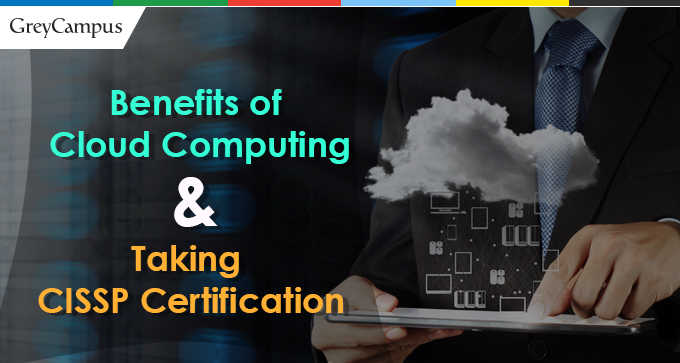Cloud Computing And CISSP – All Questions Answered
Cloud computing is the trend in the world of Information Technology. Organizations no longer need to have dedicated resources both in terms of money and people to manage their IT needs in-house. You will rarely see an IT team today which manages IT resources like Servers, CPU, RAM, bandwidth or disk space internally. All these things are now handled through cloud computing services.
What is Cloud Computing?
Simply put, Cloud Computing is a network of servers maintained in data centers that are overseen by third party service providers. The servers do not have to be in the same place as your organization or your workplace. They can be anywhere. The biggest benefit is the seamless access despite the geographic spread. You can read up on the detailed benefits and the types of service models in one of our earlier blog posts - Cloud Computing – The Global SWhattandard Of Internet Business.
How Does Cloud Computing Help?
Cloud Computing helps many ways. It helps both organizations and individuals. For an organization, the first and foremost benefit is cost advantage. In addition, organizations can now focus on utilizing IT personnel for achieving business goals and not just as a maintenance team. The most important benefit for an organization probably is the speed at which they can bounce back even in extreme calamities, as the servers stay safe.
For an individual, the benefits are huge too. You can work from anywhere, even from home while still staying connected to your office network. Most of the apps that you use on a daily basis (food delivery, cab booking, ticket booking etc.,) are a product of cloud computing.
In a nutshell, Cloud Computing is hugely helpful. It is scalable, secure, cost effective, aids business continuity, helps working from anywhere. It can’t get any better than this!
What Kind of Service Models are Available?
There are majorly three types of service models that are prevalent in Cloud Computing – Infrastructure as a Service (IaaS), Platform as a Service (PaaS) and Software as a Service (Saas).
In an Infrastructure as a Service (Iaas) model, a client can choose the infrastructure they need and pay only for those specific services. This model works for all scale of businesses.
In a Platform as a Service (PaaS) model, a software stack is offered by the cloud providers. This model works well for widely spread organizations that are into extensive web applications like an e-commerce company.
In a Software as a Service (SaaS) model, software is delivered online. Examples are all kinds of social networking sites and web based email services.
Aren’t there any Security Concerns?
While all is nice and rosy about Cloud Computing, there is room for threats. Typically, these treats are external, simply because the cloud services are delivered on a public network. It is important to anticipate, address and mitigate all such kinds of threats to information security.
How to Fight IT Security Threats?
It is important for organizations and individuals alike in the IT domain to know various ways to handle information security threats. For an organization, this knowledge helps get the right talent into their IT resource pool. For an individual, this knowledge is a brilliant value-ad that should not be missed in these times of cut throat competition.
One such value-ad and highly relevant certification with respect to handling information security threat is the CISSP certification.
What is CISSP certification?
CISSP stands for Certified Information Systems Security Professional. A CISSP certified person knows the multiple ways to look for and fight information security threat.
The CISSP is an independent certification that is governed by International Information System Security Certification Consortium also known as (ISC)². This Florida based organization aims to be the catalyst in “Inspiring a Safe and Secure Cyber World”, a slogan that is the basis of the CISSP certification.
Why take up a CISSP Certification?
As a CISSP certified professional, you naturally demonstrate the following :-
- Proven competence in Information Security that is beyond any questions
- Validated knowledge of IT threat landscape and the ways to nullify these threats
- Extensive knowledge to design frameworks for security controls
- Hands on ability to oversee risk management
- Ability to develop holistic and globally accepted Information Security practices that can withstand threats
- A serious commitment towards a career in Information Security, a much needed attribute in competitive job market
How to get CISSP Certified?
You are eligible for CISSP certification if you have 5 full time and paid years of work experience in a minimum of two of the eight domains that are considered by (ISC)². Here’s the list of the eight domains and the sub domains.
The next step is to prepare and pass the CISSP exam. If you score a minimum of 700 on 1000 you clear the exam. The exam itself is a six hour long test of your knowledge across various aspects of IT. The format of the exam is mainly multiple choice questions.
The third and the final step of the certification is the endorsement by (ISC)² which is complete only after you subscribe to the code of ethics.
How to get CISSP Training?
An exam of this nature, impact and career enhancement benefits cannot be dealt with lightly. There are all kinds of bodies that offer training needed for CISSP. It is important to choose a training program that will help you sharpen your existing skills and lend you support on skills that need strengthening. At GreyCampus, the CISSP training takes into account all the aspects of the certification. Our team of experienced and expert trainers will become a solid support system in your CISSP certification process.
Gear up for your CISSP Certification with expert Trainers!
